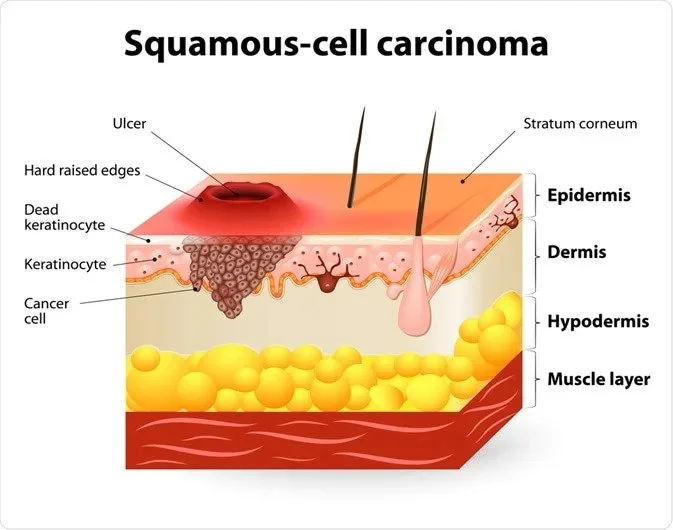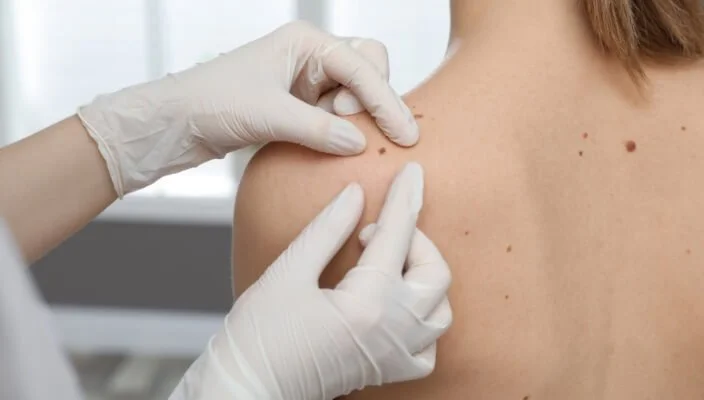The Truth About Squamous Cell Carcinoma: What You Need to Know Now!
Squamous Cell Carcinoma (SCC) is one of the most common types of skin cancer, second only to basal cell carcinoma. It arises from the squamous cells, which are found in the outer layer of the skin (the epidermis). This type of cancer can develop in any part of the body but is most commonly found in areas frequently exposed to the sun, such as the face, ears, neck, and hands. Understanding how to detect and treat SCC is crucial for ensuring effective management and improving patient outcomes.
What is Squamous Cell Carcinoma?
Squamous Cell Carcinoma is a malignant growth that arises from the squamous cells, which make up most of the skin's upper layers (the epidermis). It is a result of prolonged exposure to ultraviolet (UV) radiation from the sun or tanning beds, which causes mutations in the DNA of these cells. These mutations lead to uncontrolled cell growth, forming a tumor.
SCC can vary in appearance. It might present as a scaly red patch, an open sore, a thickened or wart-like growth, or a raised growth with a central depression. If not treated promptly, SCC can grow larger, spread to other parts of the body, and become more challenging to treat.
Risk Factors for Squamous Cell Carcinoma
Several risk factors increase the likelihood of developing SCC:
Sun Exposure: Prolonged exposure to UV radiation is the most significant risk factor.
Tanning Beds: Using tanning beds increases the risk of SCC, especially in young people.
Fair Skin: People with fair skin, light hair, and blue, green, or grey eyes are at higher risk.
Age: The risk of SCC increases with age, particularly in individuals over 50.
History of Sunburns: A history of frequent or severe sunburns increases the risk.
Immunosuppression: People with weakened immune systems, such as organ transplant recipients, are more susceptible.
Genetics: A family history of skin cancer can increase the risk.
Exposure to Certain Chemicals: Exposure to arsenic and other harmful substances can elevate the risk.
Detection of Squamous Cell Carcinoma
Early detection of SCC is vital for successful treatment. Here are the steps to detect SCC:
Regular Self-Examinations: Conduct regular self-examinations to check for any new or changing lesions on your skin. Pay close attention to areas exposed to the sun.
Annual Dermatologist Visits: Schedule an annual check-up with a dermatologist. They can perform a thorough skin examination and identify suspicious lesions early.
Skin Biopsy: If a suspicious lesion is found, a dermatologist will perform a biopsy, removing a small sample of tissue for laboratory analysis. This will confirm whether the lesion is SCC.
Treatment Options for Squamous Cell Carcinoma
Treatment for SCC depends on the tumor's size, location, depth, and whether it has spread to other parts of the body. Common treatment options include:
Surgical Excision: This is the most common treatment. The tumor is surgically removed, along with a margin of healthy tissue to ensure complete removal.
Mohs Surgery: Mohs surgery is a precise surgical technique often used for larger tumors or those in cosmetically sensitive areas. The tumor is removed layer by layer, with each layer examined under a microscope until no cancerous cells remain.
Cryotherapy: Small, superficial SCCs can be treated with cryotherapy, which involves freezing the tumor with liquid nitrogen.
Radiation Therapy: For patients who cannot undergo surgery, radiation therapy can be an effective alternative. It uses high-energy rays to destroy cancer cells.
Topical Treatments: For early-stage SCC, topical treatments like 5-fluorouracil (5-FU) or imiquimod can be applied directly to the tumor.
Photodynamic Therapy (PDT): Photodynamic therapy involves applying a light-sensitive drug to the tumor and then exposing it to a specific wavelength of light, which activates the drug and destroys the cancer cells.
Preventing Squamous Cell Carcinoma
Prevention is always better than cure. Here are some steps to reduce the risk of SCC:
Sun Protection: Wear protective clothing, wide-brimmed hats, and sunglasses. Use broad-spectrum sunscreen with an SPF of 30 or higher, and reapply it every two hours, or after swimming or sweating.
Avoid Tanning Beds: Tanning beds are a significant risk factor for skin cancer. Avoid using them entirely.
Regular Skin Checks: Perform regular self-examinations and see a dermatologist annually for a professional skin check.
Healthy Lifestyle: Maintain a healthy lifestyle to support your immune system. Eat a balanced diet, exercise regularly, and avoid smoking.
Frequently Asked Questions (FAQs)
1. Can Squamous Cell Carcinoma Spread to Other Parts of the Body?
Yes, SCC can metastasize (spread) to other parts of the body, particularly if not treated early. It commonly spreads to nearby lymph nodes and other organs, making treatment more challenging.
2. How Can I Tell if a Skin Lesion is Squamous Cell Carcinoma?
SCC can appear as a red, scaly patch, an open sore, a thickened or wart-like growth, or a raised growth with a central depression. Any new or changing lesions should be evaluated by a dermatologist.
3. Is Squamous Cell Carcinoma Curable?
Yes, SCC is highly treatable, especially when detected early. Most cases can be cured with appropriate treatment, such as surgical excision or Mohs surgery
4. How Often Should I Have a Skin Check by a Dermatologist?
It is recommended to have an annual skin check by a dermatologist. If you have a history of skin cancer or other risk factors, your dermatologist may suggest more frequent check-ups.
5. What Should I Do if I Suspect I Have Squamous Cell Carcinoma?
If you notice a suspicious lesion, schedule an appointment with a dermatologist as soon as possible. Early diagnosis and treatment are crucial for the best outcome.
Conclusion
Squamous Cell Carcinoma is a common but highly treatable form of skin cancer. Early detection through regular skin checks and prompt treatment can ensure a high success rate. By taking preventive measures, such as protecting your skin from UV radiation and avoiding tanning beds, you can significantly reduce your risk. Always consult with a dermatologist if you have any concerns about your skin health.
By following these guidelines and staying informed about the signs and symptoms of SCC, you can take proactive steps toward maintaining your skin health and preventing serious complications.





